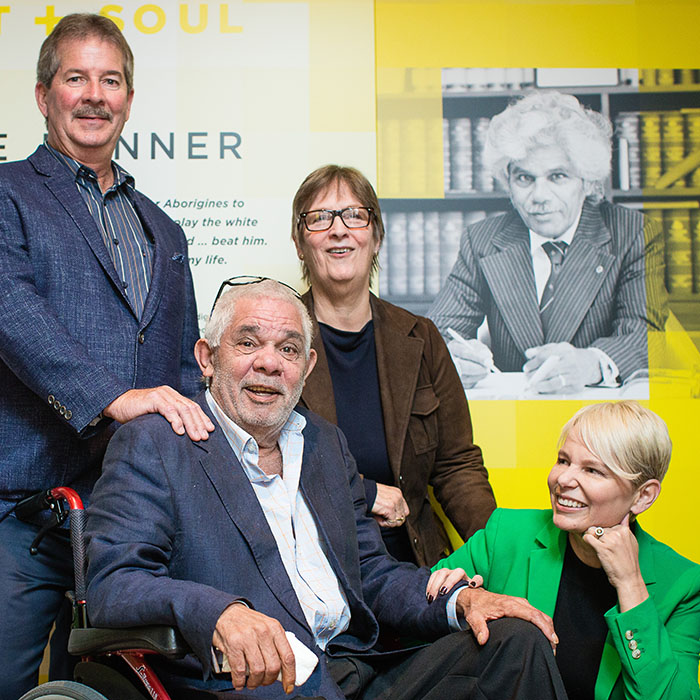
NAIDOC Week
Image credit: Museum of Australian Democracy, Old Parliament House
A handwritten note from Heather Bonner to Senator Neville Bonner, the first Indigenous Australian to become a member of the Parliament of Australia
A celebration of culture and contribution
This is a very important time of the year for me – from 02–09 July 2017, Australia will be celebrating NAIDOC Week. For those not familiar, NAIDOC is the National Aborigines and Islanders Day Observance Committee. Originating in the early 20th century, NAIDOC emerged out of Aboriginal groups seeking to highlight the treatment and status of Indigenous Australians within the wider population. One hundred years later, we now set aside the first full week in July each year to celebrate the history, culture and achievement of the Aboriginal and Torres Strait Islander community.
My proud heritage
As an Aboriginal woman, NAIDOC Week is so dear to my heart. My great uncle, Neville Bonner, was the first Indigenous Australian to become a Member of Parliament. A Jagera man from the Tweed River area in New South Wales, he made history when he became a Queensland Senator in 1971 and continued to serve as an MP up until the early 1980s. He managed to bridge the divide between Aboriginal tradition and the Australian federal political system, which was overwhelmingly dominated by white men. This is such a source of pride for me, because he laid the ground for others to come after him. He helped to ensure that minorities had a voice, or were afforded the opportunity to find a voice, and shone a light on Indigenous Australia. What makes this even more incredible to me, is that it occurred nearly fifty years ago — less than five years after our nation’s first people were formally afforded the vote. My great uncle was a passionate and dignified politician and a vocal advocate of reconciliation, while still acknowledging the difficulties presented in achieving that goal.
In recognition of Senator Bonner’s contribution to Australia, he is one of five individuals featured in a new display at the Museum of Democracy, located in Old Parliament House in Canberra. The Finders Keepers: Collectors and their Stories exhibition includes cherished items from the personal collections of Australians and aims to ask visitors why we collect and what this says about us, both as individuals and as a nation.
After my mother’s passing, I went to visit my Uncle Alfred (Tiny) on Palm Island. We sat on his porch and he spoke to me about his father, Neville Bonner. It was then that he gave me a most precious gift — a bark painting that told the story of his father’s journey to parliament.
I realised that the painting was a very important cultural piece, so I spoke with Uncle Tiny about finding a fitting home for it, to ensure that his father’s memory was kept alive. In January 2016, Uncle Alfred presented the painting to the Museum of Democracy and it now features in the Finders Keepers exhibition.
I was honoured recently to accompany Uncle Tiny and attend the launch of Finders Keepers. Items from my great uncle’s collection include a briefcase, a pillow, a pair of eyeglasses and photographs of himself with his beloved wife Heather, as well as this heartfelt, handwritten note from her. It speaks as much of who he — the man — was, as it does to highlight the importance of his political career.
Our languages matter
For me, the opening of this exhibition dovetails perfectly into NAIDOC Week, as we focus on the Aboriginal and Torres Strait Islander community, culture and achievements. Each year’s NAIDOC celebration centres on a different theme and, for 2017, the focus is on Indigenous languages under the banner ‘Our Languages Matter’.
At the time of first significant European contact, there were around 250 distinct Indigenous language groups, each including several dialects, so the actual number would have run well above that. Today, there are only 120 of those languages still spoken and, as Elders pass on, we risk losing even more.
Language plays such an important role in cultural identity and, for Aboriginal and Torres Strait Islanders, it represents a direct and crucial link between ourselves and our land and water. It is the way we transmit our history and acknowledge our ancestors. It is tied deeply to our spirituality and to our rites, which are passed on through storytelling and song. NAIDOC hopes this years’ focus will generate a greater appreciation and respect for the original languages of our nation, so all Australians will acknowledge and preserve them for generations to come.
What this means to me
It’s by no coincidence that I find myself where I am today – and by that, I mean specifically in the business I am in. My cultural legacy is that of a custodian of the land, which means I feel a responsibility to ensure that the earth is respected and precious reserves are not wasted. Beyond my heritage, I feel that same responsibility is incumbent on all of us as human beings. Regardless of our birth right, we owe it to the generations of Australians to come to ensure that our natural resources are not squandered.
As NAIDOC Week approaches, Australians from all walks of life are being encouraged to celebrate. Communities, government agencies, local councils, schools and workplaces are increasingly taking part in any number of ways, including hosting flag-raising and smoking ceremonies, inviting local Indigenous Elders to speak or to give a Welcome to Country at schools and workplaces, or hosting a community barbecue or luncheon. There are so many ways to celebrate. Visit this website for more ideas.
Narelle (right) with Uncle Tiny and family, Finders Keepers
Image credit: Museum of Australian Democracy, Old Parliament House






